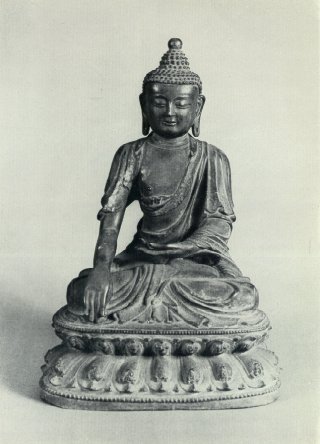|
Part 6 - The Objective of the Lotus Sutra (Commentary by Susan Kong, translated by Alan Kwan) After Shakayamni Buddha attained his enlightenment, he thought for 21 days to consider how to lead all the sentient beings to have the same blessings, virtues and wisdom as the Buddha. By that time, the Indians were very poor in living. If they were requested to help and benefit others, they would say, "How can I care others as I need care too?" Thus the Buddha felt it was impossible to gain people�s recognition and faith on his teachings. Understanding their way of thinking, the Buddha began to teach them the methods of relieving themselves from physical and mental sufferings, and of liberating themselves for comfort and happiness. That was what they wanted to get, and what they would like to believe. The Buddha expounded the Principle of Cause and Effect. He explained that our present life was due to the causes of our past lives. There were past lives and future lives in the flow of our lives. Do not accuse of the unfairness of the Creator of Universe. Do not condemn your parents to bring you to this world for suffering. It is determined by our Karma in the past lives inevitably. The feeling of happiness or suffering comes from our mind. The Buddha clearly analyzed the causes of sufferings and afflictions in our mind. For instance, you suffer because of your dissatisfaction. When you have a bowl of rice with some vegetable in hand, you may feel sad if you think of the fine food in the banquet. However, you may feel blessed if you think of hungry beggar or dog. So, you can see that suffering arises from your greed and prejudice. If you are ill-treated, why will you suffer ? It is because of your hatred and arrogance. If you suffer from separation, it is because of your ignorance, greed and hatred. If you suffer from illness, aging and death, it is because of your doubtfulness to cause and effect, your greed on self-ego and the ignorance towards the permanence of phenomena. All sufferings cannot be apart with the Five Wrong Views, i.e. greed, hatred, illusion, arrogance and doubtfulness. Thus, the Buddha taught us how to cultivate our mind, so that we can cut off afflictions, and eliminate sufferings. Naturally, everyone needs to know the ways of emancipation, as sufferings are commonly encountered in our daily lives.  The Buddha has put forward many methods to deal with greed, hatred, ignorance, etc. However, his teachings are not beyond the scope of the truth of impermanence, the principle of dependent origination, the truth of no-self, the principle of causes and conditions. In short, we suffer if we attach, we are happy if we are liberated. For cultivation, many people need not rely on others. They can do it indoor by themselves, then eradicate greed, hatred and illusion and attain self-comfort and happiness. This is known as the self-cultivating methods. Buddha is an enlightened being, but not just self-liberated. The purpose of becoming Buddha is to salvage all sentient beings. Shakyamuni Buddha let the people to cultivate in mitigation of greed, hatred and illusion. Up to that moment, the Buddha told them of the real purpose of becoming Buddha was not just for self-cultivation, but for reaching more people of different nations and races. On one hand, they should be testified and challenged with respect to their cultivation, and on the other hand, they should salvage other people in accord with their conditions and requirements. The Buddha then spoke of the Dharma of One Vehicle, not Two Vehicles nor Three Vehicles. In other words, don�t be an Arhat forever. Do study and cultivate what the Bodhisattva practice. At this stage, it should not be difficult to change to be a Bodhisattva because many obstructions have been cleared. He should know how to deal with people, to make use of his wisdom and show the people his blessings and virtues. As a Bodhisattva, one of the important practices is how to give charity and how to accept other people. If you have no greed or very minimal desire, you will give generously., If you are not jealous, you will offer your knowledge and share your experience with others without reservation. If you are not arrogant, you will be patient to others, even if you are ill-treated. If you are not lazy, you will endure and work hard. If you are not stupid and not stubborn, you will accept other�s views and have peace in your mind. In summary, if you have no greed, hatred nor illusion, you will not kill, steal, have sexual misconduct and tell lies. That means, you can hold pure precepts, then you can cultivate calmness /meditation, and finally attaining wisdom. You can then do whatever the Bodhisattvas do. The difference between Bodhisattva and Arhat is their will. If we are not self-centred and not selfish, we will become compassionate and love others. If we have a loving heart, we will not renounce the sufferings of others. Even we come across with rude people, we will have mercy on them. If we have no view of self, we will be happy when others are happy. We will not be jealous too. If we are not arrogant, we will benefit others, without caring who they are. Unless you are a remarkable Mahayana Bodhisattva, you need undergo the process of Arhat. If your roots are not ripened to become Mahayana, you have to cultivate for self-liberation, and nourish your compassionate heart in dealing with people in the world. Thus, it is easier to practice Bodhisattva�s deeds. You have to study the skills to benefit others, to facilitate and teach others, then you can reach the state of non-return. Although the Arhats can liberate from the cycle of reincarnation, i.e. no birth nor death, they are superior than the Six Paths. However, it is not the original intention of the Buddha. In Lotus Sutra, the Buddha advised all the Arhats to enter Mahayana, not just be satisfied with the liberation in Hinayana. The Buddha spoke of the Two Vehicles, which were just an expedient device. Thus, the objective of this sutra is to expound the One Vehicle. Many people say, "All religions are basically the same, as they advise people to do good." However, if we study further, we find that there is Man/Heaven Vehicle in Buddhism. It talks about the worldly wholesome deeds, which is quantified in measurable forms. The causes of wholesome deeds will yield the effects of blessings and happiness. There is also another vehicle that purify one�s mind through cultivation. There will be a peace of mind as all kinds of afflictions are eradicated. Finally, people will be liberated without being reincarnated. This vehicle is, of course, better than the Man/Heaven Vehicle. However, the Buddha advocated us to move forward in practicing Buddhism. If we do not benefit others, but just liberate ourselves, we cannot develop ourselves to be the Buddha. We are said to be Buddhist, if we can liberate ourselves, and other sentient beings as well. Shakyamuni Buddha spoke of the Dharma for 45 years. He spoke of Agama Sutras and interpreted the Five Skandhas, the Six Places, the Twelve Causes and Conditions, etc. His objective is to explain that there is no independent and permanent self, as self only exists under certain harmonized and ripened conditions. Self is "empty".  Later, when the Buddha spoke of the Prajna Sutra, he extended his theories of "no-self" to all phenomena and matters. Their existence is impermanent and in illusion. In other words, the Dharma is "empty" too. By the time that the Buddha spoke of the Sutra of Profound Understanding (解深密經), he explained the conditioned Dharma, as well as the unconditioned ones, which is different in names and forms. He also explained the Right Wisdom, True Suchness (真如) which are basically the same in principle. From the point of view in wisdom, they are all in stillness and silence. Though he said to have three kinds of self-nature, he said there had no three kinds of nature too. It is likely existent and non-empty. Stillness implied emptiness at all, and interpreted as "non-empty and non-existent". The Lotus Sutra explained thoroughly the concepts of existence and emptiness. It also explained the sole great cause and condition why the Buddha appeared in this world. It was to reveal, to show, to enlighten and to merge with the views of the Buddha.
As an analogy of a house, to reveal means to open the main door so as to know the full description and specifications of the house; to show means to display the interiors, fittings and fixtures in the house; to enlighten means to arouse the curiosity in our mind, and the interest to live; to enter and merge means to enter the house to experience in living there. No matter what the Buddha taught different Dharma to the people with different roots (talent), such as Hinayana or Mahayana, Emptiness or Existence, gradual or sudden enlightenment, the Buddha pointed to the mere One Vehicle ultimately. Just as the Lotus Sutra said, one raindrop serves water to all include three kinds of grass and two kinds of trees, which grow on their own separately.
As stated in Chapter 5 � Medicinal Herbs, "The Buddha speaks equally, Like the rain of a single flavor. According to living beings� natures, They receive it differently, Just as those herbs and trees, Each receives a different measure." The objective of the Lotus Sutra is to converge all three vehicles to One Buddha Vehicle.
|

